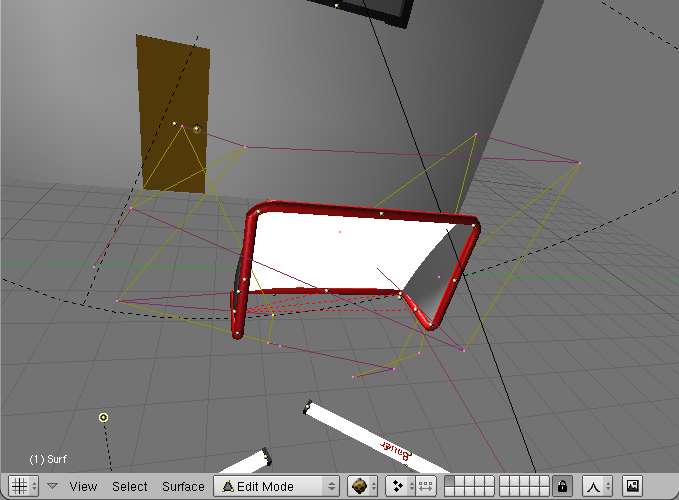Backyard Rink by Bryson Duda
I decided to go with a backyard hockey rink for my project. I constructed and rendered the scene using Blender.

The first object I put together was the hockey stick, which was fairly simple.
It's made up of 4 mesh cubes that I stretched to the appropriate sizes. There
is also the word 'Bauer' written across the side, which was done using
Blender's built-in text feature. There's a hockey puck nearby, which is just
a simple cylinder.
Next was the hockey net, which was much trickier. The horizontal and vertical
bars are made of stretched cylinders, and the curved elbows are cylinders which
have been subdivided and bent to make 90 degree curves. It was a little bit tough
trying to line up all of the "pipes" so that they all fit together properly,
if I had to do it again from scratch I would probably line things up with the
axis system to make the connections easier. The netting on the back was another
problem. I tried for quite a while to use subdivided cylinders (similar to the
elbows I made before) for the strings but didn't have any luck with that. Then I
found a Blender object called a NURBS surface, which appeared to be a mesh surface
with about 16 vertices attached to it that could be moved to have a corresponding
effect on the surface. It took a lot of time to get the surfaces stretched properly,
as you can imagine looking at this picture of the vertex arrangement that it took to
get one of the three surfaces stretched properly.

I also didn't have much luck making a texture that looked like netting, so I instead
made the NURBS surface appear as a wireframe.
The house is a cube with a pyramid on the top of it. I subdivided the cube and
removed one of it's faces to leave space for the window. It took some experimenting
to get a light that appeared the way I wanted it to, but what I ended up with was
a spotlight with a volumetric halo. The shadow on the ice below the window is
from the cross-bars in the window and not from the hockey net (I had to test it
to be sure).
I wasn't very fond of the tree, so I stuck it in the back where it's harder to see.
It's made with a cylinder and a randomly subdivided cone. I made a few attempts
at branches but decided to just stick it in the background instead.
Last is the ice, which is a flattened, stretched icosphere. The texture on it
is a built-in Blender texture called marble, which seems to work quite nicely
for ice.
This was my first attempt at using a 3D modelling program and I'm
quite happy with how it turned out. All textures used were from Blender's library.
Bryson Duda 001043687

